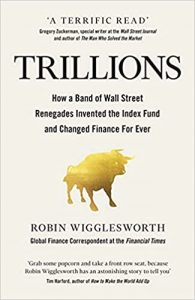In Trillions: How a Band of Wall Street Renegades Invented the Index Fund and Changed Finance Forever, Robin Wigglesworth explores the emergence of the index fund as an unrivalled invention in recent financial history. Taking the reader on a road trip through the history of financial markets, this readable book will be enjoyed by those who have studied economics and are interested in connecting familiar concepts, writes Maria Zhivitskaya.
Trillions: How a Band of Wall Street Renegades Invented the Index Fund and Changed Finance Forever. Robin Wigglesworth. Penguin Business. 2020.
 Robin Wigglesworth, the Financial Times’s global finance correspondent who focuses on the biggest trends reshaping markets, argues in his latest book that the index fund is an unrivalled invention in recent financial history. Trillions explains the history of financial innovation and index investing, told through the intimate account of individual ‘Wall Street renegades’ and those around them who made it possible. Index funds are presented unambiguously as a force for good, driving down the fees payable to finance professionals and thereby bringing substantial tangible benefits to individual investors saving for retirement and other financial goals.
Robin Wigglesworth, the Financial Times’s global finance correspondent who focuses on the biggest trends reshaping markets, argues in his latest book that the index fund is an unrivalled invention in recent financial history. Trillions explains the history of financial innovation and index investing, told through the intimate account of individual ‘Wall Street renegades’ and those around them who made it possible. Index funds are presented unambiguously as a force for good, driving down the fees payable to finance professionals and thereby bringing substantial tangible benefits to individual investors saving for retirement and other financial goals.
The rise of index investing is a powerful trend in finance – Bloomberg estimates that passive management now comprises 43 per cent ($10 trillion) of US-based mutual fund and exchange-traded funds (ETFs), compared with 32 per cent ($4.1 trillion) in 2015. Globally, over $26 trillion – more than a year’s economic output in America – is now held in such funds, which is ‘almost twice the size of the combined private equity, venture capital and hedge fund industries’. The fundamental principle of index funds is being ‘average’. The majority of active managers charge at least 1-2 per cent per year while failing to beat the market over the medium term: ‘Statistics vary, but […] only 10 to 20 percent of active funds beat their benchmarks over any rolling ten-year period’ (8). In contrast, index funds charge as little as 0.03 per cent for closely tracking a large equity index.
Trillions starts with a famous bet between Warren Buffett and New York-based Protégé Partners, a specialist asset management and advisory firm. In 2007, Buffett bet $1 million that no investment professional could pick a portfolio of at least five hedge funds that would outperform a low-fee S&P 500 index fund over the subsequent decade. Active managers with their high fees, Buffett explained, were starting at a disadvantage and needed to compensate for those fees. Buffett argued in his 2016 letter to investors that the active managers’ efforts ‘were to a great extent self-neutralising and their IQs would not overcome the costs they are charging end-investors’ (22). Buffett chose the low-cost Vanguard fund and won the bet a decade later, resulting in a charity donation. Naturally, ‘Buffett argues that being a professional investor is not an impossible task, but he is sceptical that many can succeed’ (16). ‘The bet is symbolic of bigger shifts in the industry’, Wigglesworth explains.

Trillions takes the reader on a well-articulated road trip through the history of financial markets from their academic origins before moving on to indexing, mutual funds, ETFs and responsible investment products. It is an easy read, told through lively, relatable stories of those involved.
We begin our journey in France in 1900, with French mathematician Louis Bachelier’s random walk hypothesis based on his PhD, and over time we get to know Harry Markowitz, William Sharpe, Eugene Fama, Fischer Black and Myron Scholes, John Clifton ‘Jack’ Bogle and Larry Fink, all of whom contributed to the evolution of finance theory, paving the way for the emergence and triumph of index funds. For those who have already studied economics, this book captivatingly connects the dots between names you are already likely to be familiar with. There are a lot of PhDs from the University of Chicago, with numerous colleagues in common and a shared desire to innovate at the intersection of industry practice and academia.
The author appears particularly fond of Vanguard and its founder, John Clifton ‘Jack’ Bogle. Following an economics degree from Princeton University, Bogle launched his career in active investing in Wellington but was asked to resign twenty years later due to a failed merger. This drove him to create Vanguard in 1975, now the world’s second-largest asset manager. Wigglesworth muses that no one is more religious than a convert – once an active manager, Bogle changed his position to become an avid supporter of passive management and created the first index fund available to individual investors. As a mutual organisation, Vanguard could operate at cost, returning any profit to its constituent funds, thereby further reducing fees for its customers.
Edward ‘Ned’ Johnson, the son of Fidelity’s founder who was responsible for its rise to one of the world’s largest asset managers, observed: ‘I can’t believe that the great mass of investors are going to be satisfied with just receiving average returns. The name of the game is to be the best’ (114). However, Vanguard reshaped the landscape by finding a niche as a low-cost, market-mimicking provider in a high-cost industry.
ETFs were the next significant innovation in indexing, which the book explains in detail. ETFs hold multiple underlying assets, but they are traded on an exchange just like stocks, so they tend to be more cost-effective and more liquid compared to mutual funds. Fink, Blackrock’s CEO and a member of the ‘rarefied ranks of corporate executives referred to only by their first name’ (234), compares the impact of ETFs with how Amazon transformed retail – with lower prices, convenience and transparency, as opposed to the asset management industry’s complexity and opaqueness.
Wigglesworth celebrates this passive revolution, but does not spend enough time on the potential pitfalls. Much of the book is drawn from various biographies and memoirs, so it could be accused of over-simplification, full of the success stories of brilliant Ivy League graduates. There must have been more missteps along the way than we get to know, and it would have been helpful to read about them.
Another shortcoming is the book’s US-centric perspective, with European and Asian players barely mentioned. An exception was the call from Simon Pilcher, head of the Universities Superannuation Scheme (USS), one of the UK’s largest pension schemes, to redirect its activities away from mainstream active equities, despite the strong performance of their mandates, in favour of thematic quantitative strategies and passive mandates (274).
Wigglesworth churns out the classic quote that ‘it’s hard to make predictions, especially about the future’, then abides by this by declining to extrapolate on past performance or to discuss how index funds or the finance landscape broadly might develop. The book presents a readable overview of financial markets through the lens of index investing, and will be enjoyable to those who studied economics and are interested in connecting familiar concepts. Perhaps Wigglesworth’s next book could include an examination of more recent developments, including the expansion of environmental, social and governance investments as well as the rise of alternatives and private capital markets.
- This review first appeared at LSE Review of Books.
Please read our comments policy before commenting.
Note: This article gives the views of the author, and not the position of USAPP – American Politics and Policy, nor of the London School of Economics.
Shortened URL for this post: https://bit.ly/39muee5
About the reviewer
Dr Maria Zhivitskaya obtained a PhD in Risk Management from LSE in 2015. She now works in the asset management industry specialising in ESG. She also teaches master’s degree candidates at Paris School of International Affairs and MBA students at Saïd Business School in Oxford.






